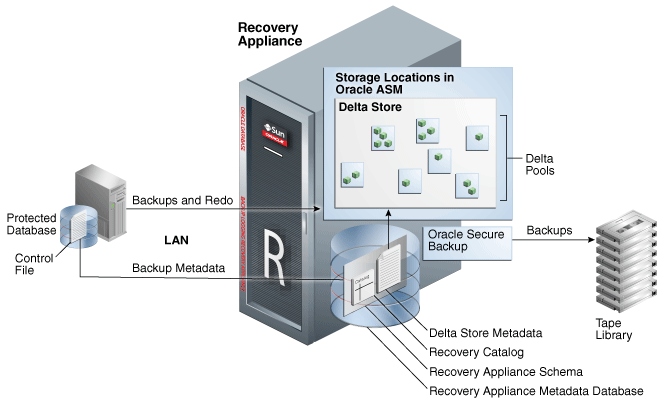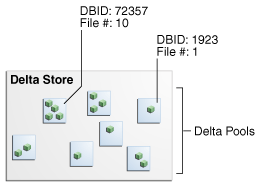Recovery Appliance Metadata Database
The key component of the Recovery Appliance is the Recovery Appliance metadata database. This database manages metadata for all backups, and also contains the RMAN recovery catalog. The Recovery Appliance metadata database is preconfigured, pretuned, and managed by the Recovery Appliance. Figure 2-5 depicts a Recovery Appliance metadata database interacting with a protected database.
Figure 2-5 Recovery Appliance Metadata Database

Description of "Figure 2-5 Recovery Appliance Metadata Database"
This section contains the following topics:
Delta Store
The delta store is the totality of all protected database backup data in Recovery Appliance storage location. All data file and archived redo log backups reside in the delta store. The delta store contains delta pools for all data files in all protected databases.
Delta Pools
The delta store is the collection of delta pools. As the Recovery Appliance receives backups from protected databases, it indexes them and stores them in delta pools. A delta pool is the set of data file blocks from which Recovery Appliance constructs virtual full backup. Recovery Appliance automatically manages delta pools so that it can create a virtual full backup that corresponds to any incremental backup ever received.
Each separate data file whose backups are sent to Recovery Appliance has its own separate delta pool. For example, data file 10 from prod1 has its own delta pool, data file 1 from database prod2 has its own delta pool, and so on. As shown in Figure 2-6, the delta store contains all the delta pools for the databases protected by Recovery Appliance.
Automated Delta Pool Space Management
The set of operations by which Recovery Appliance manages backups is called automated delta pool space management. Specifically, space management involves the following automated tasks:
-
Deleting backups (both in a Recovery Appliance storage location and on tape) that are obsolete or expired based on the disk recovery window goal and SBT retention policy
Recovery Appliance periodically determines that some backups no longer need to be stored on disk, so their disk space can be reclaimed. When the Recovery Appliance determines that some backups residing in the delta pools are obsolete, the individual blocks that compose those backups are typically located in physical files alongside non-obsolete blocks. Recovery Appliance rewrites these physical files so that the delta pools can reclaim the space occupied by the obsolete blocks.
-
Reorganizing the delta pools periodically to improve performance of restore operations
The automatic tracking and reorganizing of the delta pools is called delta pool optimization. As old blocks are deleted and new incremental backups arrive for updated data files, the blocks in a backup can become less contiguous. This state can degrade the performance of restore operations. Recovery Appliance runs a background task that automatically reorganizes virtual full backup blocks to maintain contiguity, thus optimizing read access for restore operations.
See Also:
Recovery Appliance Schema
The Recovery Appliance schema contains metadata used internally by the Recovery Appliance to manage backups on behalf of its protected databases. RASYS is the Recovery Appliance administrative user who owns the Recovery Appliance schema. The Recovery Appliance schema contains the RMAN recovery catalog.
Recovery Appliance Catalog
Updates to the recovery catalog reflect the results of Recovery Appliance indexing and space management collection. These updates do not occur in the control files of the protected databases. For this reason, protected databases that store backups in the Recovery Appliance must use the Recovery Appliance catalog.
Note:
Protected databases may use the recovery catalog in the Recovery Appliance without also using the Recovery Appliance as their backup repository.
RMAN connects to the Recovery Appliance catalog using the same Recovery Appliance account employed for backup and recovery operations. Each Recovery Appliance user account is also a virtual private catalog account. The DBMS_RA.GRANT_DB_ACCESS procedure grants Recovery Appliance privileges to a database user account for a specified protected database.
See Also:
-
Oracle Database Backup and Recovery User's Guide to learn how to manage a recovery catalog
